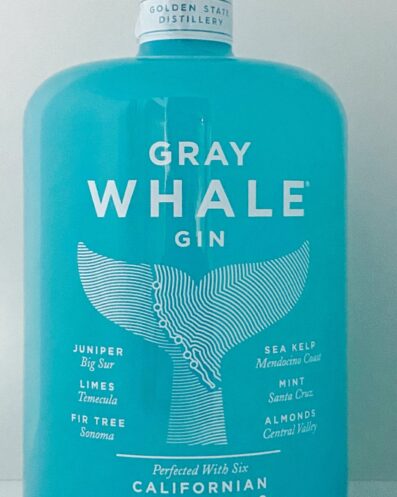Inspired by the sight of a migratory Gray Whale, while on a camping trip, Jan and Marsh Mokhtari came up with the concept of Gray Whale Gin. The gin’s botanical bill that story through California-grown botanicals.
From Mendocino grown sea kelp to Persian Limes grown in Temecula, all are sourced sustainably. Further, there’s a nice “feel good” bonus. Gray Whale Gin donates 1% of all profits to environmental causes.
The gin is slickly presented in a distinctive blue bottle. If you’ve been at a gin bar in the last couple years, you’ve most certainly seen it. It’s perhaps the best recognized bottle since Hendrick’s launched with its apothecary vessel in the late 90’s.
Technically speaking, Gray Whale Gin is distilled from a corn base. The botanicals are split into two groups. The lime and fir needles are vapor distilled; the remaining are distilled directly in the corn spirit.
Tasting notes
Color: Perfectly clear and transparent.
Aroma: Citrus, with lemony notes, hints of mint and evergreen inspired pine. As it sits, a warming, earthy nuttiness begins to emerge.
Flavor: A faint nuttiness with gentle echoes of mint on the entry. Pine-forward juniper mid-palate echoes both juniper and fir needles.
Slightly sweet, the botanicals evoke a texture and richness to the palate.
Lime skins, citrus pith, and herbaceous pine segue into a minty, slightly mineral sensation in the back of the palate.
Finish: Gently warm with very little burn. The botanicals lend Gray Whale Gin an impressive tenacity on the palate when sipping it neat. However long it may be, it feels rather one note and slight given the botanical intensity elsewhere.
Cocktails
Gray Whale Gin’s botanical strength is concentrated in the top and middle. Pairing it with a mixer that adds a late base note (like tonic water in a gin and tonic, or using club soda for that added minerality in a gin and soda) help lengthen the flavor.
It’s a solid mixing gin. Bartenders will find that while it does lean contemporary, the flavor profile works in a wide variety of applications. It’s smooth enough and light enough in heat to work in Martini type cocktails such as the Arsenic and Old Lace or the Gibson.
Up front, you’ll taste the juniper and pine in a Negroni, but the finish will be carried by the Campari.
Overall, Gray Whale Gin
Gray Whale Gin is very on trend in terms of a modern turn towards herbal, savory gins. However, there’s a balance here that keeps it from being a one-note herbal gin. The mint is subtle and present, but not overwhelming. The almond does a lot of heavy lifting and adds some base notes to a gin that is botanically heavy on the lighter, more volatile side.
But where I most enjoy it is in how the fir buoys the juniper. While I’d still say Gray Whale Gin is contemporary in approach, the lovely juniper flavor with multiple facets more than holds its own.
Where I’d perhaps offer a critique is that it feels a bit weak in the base notes and finish. I’d love some more depth there and some additional complexity beyond the trigeminal sensations of minerality and perceptive salinity. A bit of angelica and/or orris root might have really added something here.
But overall, Gray Whale Gin is a solid product that is more than a novelty— it’s a good gin in a distinctive bottle. Worthy of a try for fans of contemporary style, herbal gins.


This is a most perfect Gin!!! Luv it replaces my Hendrix
My favorite gin, mixes well with all drinks I have made. Probably the best gin I use when drinking Gin & Juice it complements the juice with subtle forward taste but let’s the juice run the aftertaste, leaving a smooth and easy sipping drink. Bombay is good to IMO but is opposite for the flavor profile and is a better mixer for drinks that require floral heat.
Just started drinking Negroni’s. Grey Whale adds a great new dimension to this drink.
Makes the best Gin and Tonic I have ever had.
This is wonderful, my new #1 favorite gin for G&Ts, heading to buy another bottle now!!
I’m absolutely going to try this very intriguing gin.